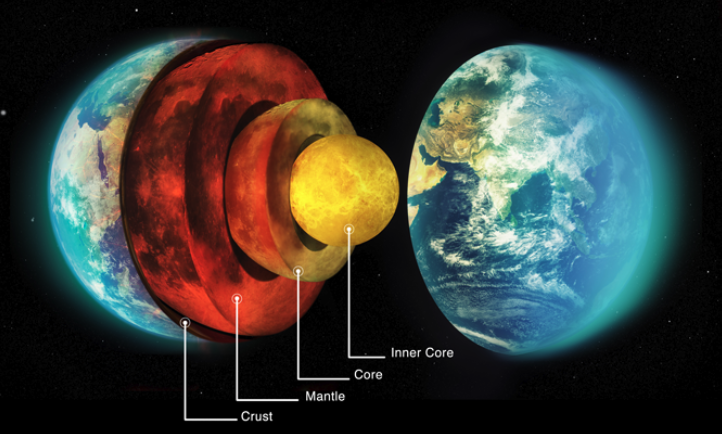Study Guide: Layers of Planet Earth
Main Ideas
- The Earth is composed of four layers. They are, from deepest to shallowest, the Inner Core, Outer Core, Mantle and Crust.
- The Inner Core is a solid ball of metal (mostly iron and nickel), that is close to the temperature of the surface of the Sun. Although it is hot enough to melt metal, the gravitational pressure is so high the the metal remains in a solid state. The Inner Core is rotating faster than the rest of the planet.
- The Outer Core is liquid metal. It is also very hot, but because the gravitational pressure is lower, the metal is able to melt.
- The Mantel is the largest layer of the Earth. It is made of Magma (molten rock). This is where diamonds and many other rare minerals are formed. The lava in volcanoes comes from the Mantel.
- The Crust is outer surface of the planet. It is very thin (between 5 to 30 miles in most areas). The Crust is made of Tectonic Plates that are floating on the Magma of the Mantel. We live on the Crust.
The Layers of the Earth
The Earth is composed of four layers. They are, from deepest to shallowest:
- Inner Core
- Outer Core
- Mantle
- Crust
Except for the crust, no human has ever explored these layers in person. In fact, the deepest we have ever drilled is just over 12 kilometers (7.6 miles), and that took 20 years! Even so, scientists have learned a lot about interior of the Earth.
So, how do we know so much about the interior of the Earth? Good question. Actually, we don’t know very much. Most of our ideas are based on indirect observations. For example, scientists—including Isaac Newton, three centuries ago—studied the Core and Mantle by calculating the Earth’s total density, gravitational pull and magnetic field.
More recently, scientists studied how earthquake waves travel through the planet. The speed and behavior of these waves changes as they encounter layers of different densities. In fact, it was the behavior of these waves that first gave scientists the idea that the Earth must be made up of several layers.
You can see the same effect when you look at a stick in water. The stick will appear to bend at the point where it enters the water. This is because the light waves bend at the boundary of the air and water. The evidence seems convincing, but no one knows for sure yet. If you have a better idea, test it. (More on this in our Physics Block…)
The Inner Core
The Inner Core is a solid metal ball with a radius of 1,220 kilometers (758 miles). This is about $\frac{3}{4}$ the size of the moon. It’s extremely dense and heavy is mostly made of iron and nickel.
Strangely, the Inner Core spins faster than the rest of the planet. It’s also intensely hot. At 5,400° Celsius (9,800° F), it’s almost as hot as the surface of the Sun. The Inner Core is solid because the pressures here are so high that they do not allow metal to melt.
The Outer Core
The Outer Core is also made of iron and nickel, but it is in liquid form. It is heated largely by the radioactive decay of radioactive elements, this liquid metal churns in huge, turbulent currents, and this is the motion that generates the Earth’s electrical currents and magnetic fields.
For reasons somehow related to the Outer Core, the Earth’s magnetic field reverses about every 200,000 to 300,000 years. Scientists are still trying to understand why.
The Mantle
At close to 3,000 kilometers (1,865 miles) thick, this is Earth’s thickest layer. It starts about 30 kilometers (18.6 miles) beneath the surface. Made mostly of iron, magnesium and silicon, it is dense, hot and gooey (like caramel candy). The Mantle also circulates, but far more slowly than the Outer Core.
The Lithosphere
The Mantle’s outermost zone is relatively cool and rigid. It behaves more like the Crust above it. Together, this part of the Mantle and the Crust are known as the Lithosphere.
The Crust
Earth’s Crust is like the shell of an egg. It is extremely thin, cold and brittle compared to the lower layers. The Crust is made of relatively light elements, such as Silica, Aluminum and Oxygen. The Crust varies greatly in thickness.
Under the Oceans (and near the Hawaiian Islands), the Crust may be as little as 5 kilometers (3.1 miles) thick. Beneath the continents, the crust can be 30 to 70 kilometers (18.6 to 43.5 miles) thick.
Tectonic Plates
About 100 to 200 kilometers (62 to 124 miles) underground, the Mantle’s temperature reach the melting point of rock. Geologists think this hot, slippery layer of the Mantle is what the Earth’s Tectonic Plates float on. (Learn more on Tectonic Plates here)
Diamonds
The diamonds that people value so highly are tiny pieces of the Mantle that formed in great heat, and were then pushed to the surface in volcanic rock known as Kimberlite.

Elements in the Earth’s Crust







